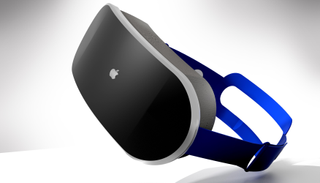Apple VR and AR headset leak just revealed two killer features
Apple's upcoming headset can see where you're looking, and that's a good thing

The upcoming Apple VR and mixed reality headset may have an interesting feature, according to analyst Ming-Chi Kuo (via 9to5Mac). Kuo claims the headset will be able to track eye movement, blinking, and may even include biometric iris recognition.
Those sound like features pulled straight out of a sci-fi novel, but they’re not as crazy as you might thinks. Especially not for a headset that’s set to as advanced as Apple’s.
- Everything we know about the Apple VR and mixed reality headset
- Apple Glasses: What to expect from Apple's AR lenses
- Plus: Can’t find Nvidia RTX 3080? Intel could reveal Xe HPG graphics this month
Apple’s VR and mixed reality headset is already tipped to come with a number of external sensors. Rumors claim those are built to handle see-through AR capabilities, body tracking and obstacle detection. The headset is also set to feature LiDAR, which will boost the accuracy of the AR features.
But Apple clearly isn’t stopping there. Kuo claims that the Apple headset will feature “sophisticated” eye tracking, which will be able to detect exactly where users are looking and whether they’re blinking. This could take the place of handheld controllers.
Kuo also mentions the iris recognition feature, which will reportedly function as an equivalent to Face ID and identify the headset’s user automatically. The iris recognition could also help authenticate payments through the App Store and other purchases, though Kuo is not certain if this feature will be ready in time.
None of these things are actually new, of course. Eye tracking has been a feature on certain high-end VR headsets, like the HTC Vive Pro, for some time. As for iris recognition, that was a feature on Samsung flagships for several years — starting with the Samsung Galaxy Note 7. It's all in how Apple plans to use these technologies.
What's so good about eye tracking?
Past reports have claimed Apple is working on designing its mixed reality headset to be powerful, but also light and comfortable. Those two things rarely mix in a headset, but eye tracking can help facilitate this in its own way.
Sign up to get the BEST of Tom’s Guide direct to your inbox.
Upgrade your life with a daily dose of the biggest tech news, lifestyle hacks and our curated analysis. Be the first to know about cutting-edge gadgets and the hottest deals.
If a headset can tell exactly where a user is looking, then everything else on screen is of little consequence. That means the headset could dynamically scale down the resolution and quality of everything you’re not focussed on. That way the headset doesn’t waste CPU and GPU resources on something a user isn’t going to see.
Plus, rendering an entire display at the same time takes up a lot of computing power. This is especially true if the Apple headset will be offering an 8K display. The smaller the area, the less computing power you need, and that means Apple can get away with using less powerful components.
Plus, by not overworking the CPU and GPU on display elements that aren’t going to be seen, it reduces power consumption and heat generation. That means Apple can also use a smaller battery and cooling system, which will help reduce the overall weight of the headset.
The Apple VR and mixed reality headset is expected to arrive in mid-2022, and reports claim it may cost either $1,000 or $3,000. Either way, it’s designed to be an ultra-premium headset with AR pass capabilities, and will act as the precursor to the hi-tech AR Apple Glasses.
- More: iPhone 13: What we know about the next iPhone

Tom is the Tom's Guide's UK Phones Editor, tackling the latest smartphone news and vocally expressing his opinions about upcoming features or changes. It's long way from his days as editor of Gizmodo UK, when pretty much everything was on the table. He’s usually found trying to squeeze another giant Lego set onto the shelf, draining very large cups of coffee, or complaining about how terrible his Smart TV is.
